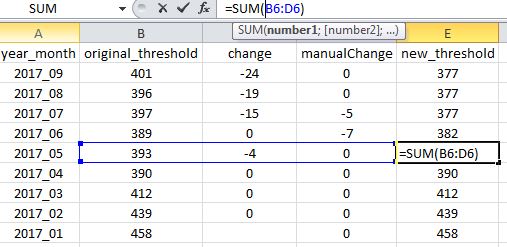I have the following in Excel which I need to calculate in SQL Server:
The columns that needs to be calculated is change and new_threshold:
The formula for change is:
While the formula for new_threshold is:
I have tried to use the lead and lag methods SQL Server offers, but I can't seem to keep track of the calculation.
Here is one thing I've tried:
SELECT
year_month,
round(original_threshold, 0) original_threshold,
round(case when original_threshold > isnull(lead(original_threshold) over (order by [year_month] desc), original_threshold)
then isnull(lead(original_threshold) over (order by [year_month] desc), original_threshold) - original_threshold
else 0 end, 0) change,
manualChange,
round(original_threshold + case when original_threshold > isnull(lead(original_threshold) over (order by [program], [year_month] desc), original_threshold)
then isnull(lead(original_threshold) over (order by [year_month] desc), original_threshold) - original_threshold
else 0 end + manualChange, 0) new_threshold
FROM
[Test].[dbo].[test]
which yields:
Edit:
Here is the insert statement if you want to test it
insert into [Test].[dbo].[test]
(
[year_month]
,[original_threshold]
,[manualChange]
)
values
('2017_09', 401, 0),
('2017_08', 396, 0),
('2017_07', 397, -5),
('2017_06', 389, -7),
('2017_05', 393, 0),
('2017_04', 390, 0),
('2017_03', 412, 0),
('2017_02', 439, 0),
('2017_01', 458, 0)
Based on the values from this insert, I want to be able to calculate the change and new_threshold like in the Excel above.




